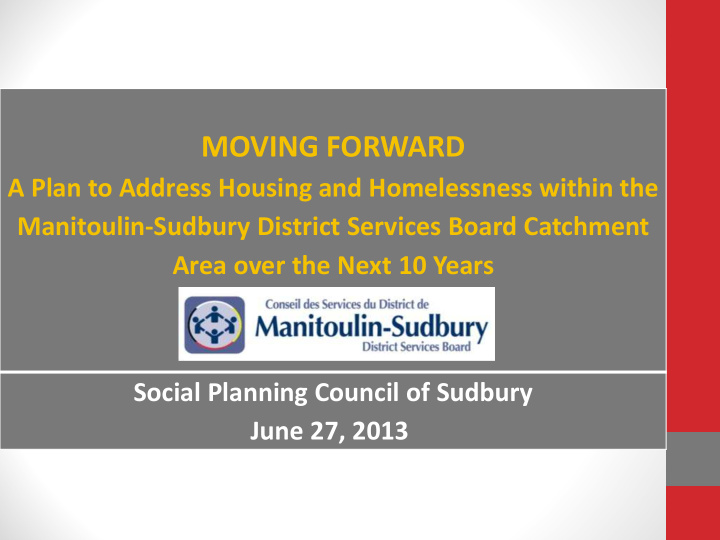



Moving Forward Moving Forward MOVING FORWARD A Plan to Address Housing and Homelessness within the Manitoulin-Sudbury District Services Board Catchment Area over the Next 10 Years Social Planning Council of Sudbury June 27, 2013
Overview of the Task as per the Ministry • Ontario Long-Term Affordable Housing Strategy requires a 10 Year Housing & Homelessness Plan by Jan. 2014. Plans are to be locally driven and respond to local need. • The Manitoulin-Sudbury DSB is responsible for producing an H&H Plan for 18 municipalities and two unorganized territories. • Recognize the Housing First Model - Stable and permanent housing is considered to be the first step in a person’s journey toward stability in multiple aspects of life, should the individual agree and wish to be housed at that time. • The Manitoulin-Sudbury DSB contracted the Social Planning Council of Sudbury (SPCS) to lead the development of the plan.
What is known about Rural Homelessness • It’s under-studied • Hard to understand – relatively invisible compared to urban homelessness. Generally speaking, individuals and families at- risk of homelessness in rural areas tend to more readily experience living in substandard or overcrowded housing or living with friends or family rather than experiencing absolute homelessness (Reid & Katerburg, 2007). • Rural areas would benefit from having a data collection coordinator who would maintain good relationships with service providers and advocates, facilitate data collection training, and overall create a standard for data collection, quality assurance, and dissemination (Toomey & First, 1993).
Gathering Information for The Plan • The key priorities of the plan were informed by Community Profile Data (Statistics Canada) and by community consultations 12 focus groups/six communities Several telephone/email interviews (open-ended questions) • Participants included: Social and non-profit housing tenants; persons in low income living in market rent; service providers/community agency workers; board members, mayors and other municipal reps
Issues at the Forefront of Stable Housing/Living • Widespread geography access to services and amenities further compromised by limited transportation options and diluted information flow • Lack of housing that is affordable for people in low income • Staggering senior and aging population who require affordable housing with regular supports • Lack of known supports in place for at-risk youth/no service connections to schools • Housing is part of a larger context, impacted by the state of the labour market and accessibility to education
Key Priorities Identified 1. Understand and Respond to the District’s Demographic 2. Strong Emphasis on Seniors Required – Housing and Supports 3. Implement Strategies to Support Overlooked Populations – Aboriginals, Youth, and Individuals who are Homeless 4. Address Gaps in Services that Contribute to Homelessness 5. Imperative Action on Improving Transportation Accessibility Required 6. Employment and Training Opportunities
Key Priorities, continued… 7. Energy Efficiency and Sustainable Housing 8. Innovation and Efficiency with Affordable Housing 9. Increase Opportunities by Increasing Knowledge Dissemination 10. Spearhead Integrated Service Delivery 11. Increased Advocacy Role for Civic Leaders 12. Increase Program Evaluation 13. Closely Monitor the Release of RFPs and Funding Opportunities
References • Reid, D. & Katerburg, L. (2007). Understanding Homelessness and Housing Stability in Waterloo Region’s Rural Areas . ON: Regional Municipality of Waterloo. • Toomey, B.G, & First, R.J. (1993). Counting the rural homeless population: Methodological dilemmas. Social Work Research & Abstracts, 29 (4), 23-27.
Recommend
More recommend